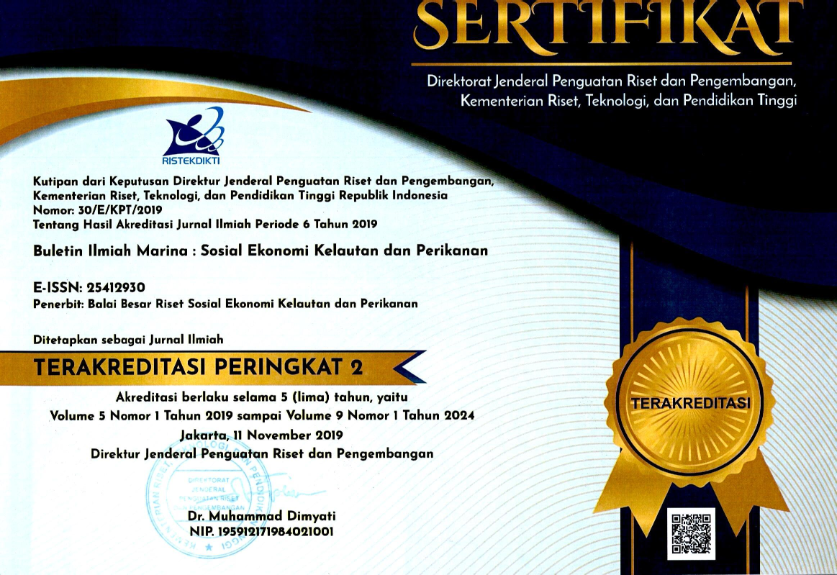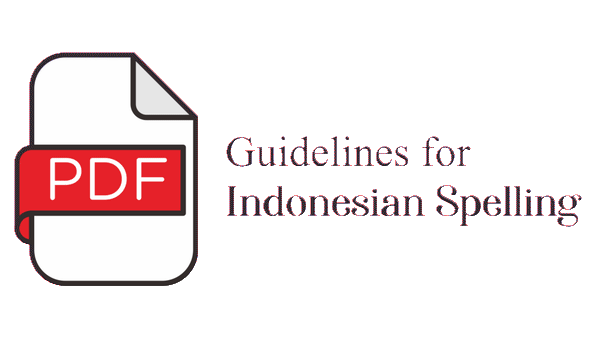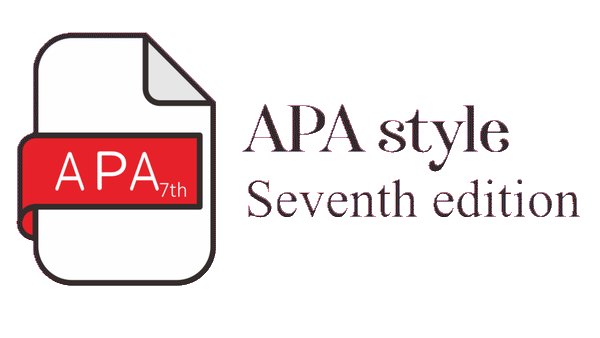Pengorganisasian Nelayan Skala Kecil di Zona Penangkapan Ikan Perikanan Industri dalam Mendukung Rencana Kebijakan Penangkapan Ikan Terukur
Abstract
Kebijakan pengelolaan penangkapan ikan di laut Indonesia sudah direncanakan akan bergeser dari kebijakan kontrol input menjadi kebijakan kontrol output. Izin penangkapan ikan dengan kebijakan pertama diberikan kepada armada dan alat tangkap, sedangkan kebijakan kedua didasarkan pada kuota ikan yang ditangkap dengan armada perikanan dan alat tangkap. Tujuan utama penelitian ini adalah untuk mempelajari kondisi perikanan tangkap skala kecil (nelayan lokal) jika kebijakan kontrol output dilaksanakan. Dua tujuan lain, yaitu: mempelajari tiga prinsip pengorganisasian nelayan skala kecil; serta melakukan penilaian terhadap indikator aksi kolektif pada koperasi nelayan di lokasi penelitian, terkait strategi memperoleh kuota penangkapan ikan. Perikanan skala kecil <10 GT jumlahnya mencapai 90% dari total armada perikanan tangkap. Usaha perikanan skala kecil biasanya tidak terorganisasi dalam sebuah bisnis yang terorganisasi, tetapi kontribusi terhadap produksi ikan Indonesia mencapai 50%. Nelayan lokal secara teoretis dapat diorganisasikan dan pengorganisasian tersebut dapat dilakukan melalui koperasi untuk melakukan aksi kolektif. Pengumpulan data primer dilakukan melalui survei dan focus group discussion (FGD) di Kabupaten Natuna dan Sebatik (Kabupaten Nunukan) serta PPS Cilacap pada bulan Mei sampai dengan September 2021. Penelitian ini menggunakan sepuluh indikator (atribut) dalam menilai aksi kolektif nelayan lokal (perikanan skala kecil) melalui koperasi atau korporasi untuk memanfaatkan kuota penangkapan ikan. Data yang dikumpulkan dianalisis dengan statistik deskriptif. Hasil penelitian ini menunjukkan bahwa sekitar 85% perikanan skala kecil menangkap ikan di perairan >12 mil. Armada perikanan skala kecil yang menangkap ikan di perairan >12 mil (pada zona industri perikanan) harus bergabung dalam koperasi atau korporasi agar sesuai dengan regulasi. Pembentukan koperasi/korporasi pada usaha perikanan skala kecil dilakukan melalui konsolidasi, kolaborasi, dan integrasi. Penelitian ini merekomendasikan bahwa atribut tersebut dapat digunakan sebagai acuan untuk pengorganisasian nelayan skala kecil di dalam koperasi atau korporasi di berbagai zona industri penangkapan ikan dan di berbagai wilayah pengelolaan perikanan negara Republik Indonesia.
Title: Organizing Small Scale Fishers for Catching Fish in The Industrial Fishing Zone to Support A Measurable Fishing Policy Planning
The fishing policy on Indonesian seas is in the plan to shift from an input control policy to an output control policy. The first policy, fish license, is given to the fishing fleet and gear, while the output control policy focusc on the quota of fish caught to the fishing fleet and fishing gear. The main purpose of this research is to study the condition of small-scale capture fisheries (local fishers) if the output control policy is implemented. Two other objectives were also studied related to the principles of organizing small-scale fishers, as well as indicators of collective action in small-scale fisheries organizations. Small-scale fisheries <10 GT account for 90% of the total fishing fleet. The small-scale fishery businesses were not organized in an organization but contributed to Indonesian fish production, reaching 50%. Fishers theoretically are organized, and the organization can be through cooperatives to carry out collective action. Primary data was collected through surveys and focus group discussions (FGD). The data were collected in Natuna Regency and Sebatik island (Nunukan Regency) and Cilacap Ocean Fishing Port from May to September 2021. This study uses ten indicators (attributes) to assess the collective action of local fishermen (small-scale fisheries) through cooperatives or corporations to take advantage of fishing quotas. The data collected were analyzed by descriptive statistics. The study results indicate that about 85% of small-scale fisheries catch fish in waters > 12 miles. To comply with regulations, small-scale fishing fleets that catch fish in waters > 12 miles (in industrial fishing zones) should have to join with cooperatives or corporations. The formation of cooperatives/corporations in small-scale fishery businesses through consolidation, collaboration, and integration. This study recommends that these attributes use as a reference for organizing small-scale fishers in cooperatives or corporations in various fishing industry zones throughout the Republic of Indonesia Fisheries Management Area.
Keywords
Full Text:
PDFReferences
Bernard, T., & Spielman, D.J. (2009). Reaching the rural poor through rural producer organizations? A study of agricultural marketing cooperatives in Ethiopia. Food Policy, 34(1), 60—69. https:// doi.org/10.1016/j.foodpol.200808001.
Cabral, R. B., Mayorga, J.S., Clemence, M., Lynham, J., Koeshendrajana, S., Muawanah, U. & D. Nugroho. (2018). Rapid and lasting gains from solving illegal fishing. Nature Ecology and Evolution, 2, 650—658 https://doi.org/10.1038/ s41559-018-0499-1.
California Environmental Associates. (2018). Trends in Marine Resources and Fisheries Management in Indonesia: A 2018 Review. https://www. packard.org/wp-content/uploads/2018/08/ IndonesiaMarine-Full-Report-0807.2018.pdf.
FAO. 2018. The State of World Fisheries and Aquaculture 2018 – Meeting the Sustainable Development Goals. FAO, United Nations, Rome. http:// www.fao.org/3/ i9540en/ I9540EN.pdf.
FAO. 2020. The State of World Fisheries and Aquaculture Sustainability in Action 2020. FAO, Rome. ISBN 978-92-5-132692-3.
Forney, J., & Haberli, I. (2017). Cooperative values beyond hybridity: The case of farmers’ organisations in the Swiss dairy sector. J. Rural. Stud, 53, 236–246. https://doi.org/10.1016/j. jrurstud.2017.04.003.
Francesconi, G.N., & Heerink, N. (2011). Ethiopian agricultural cooperatives in an era of global commodity exchange: Does organisational form matter?. Journal of African Economies, 20(1), 153–177. https://doi.org/10.1093/jae/ejq036.
Fernando, S.E., Garnevska, T., Ramilan, N., & Shadbolt. (2021). Organisational attributes of cooperatives and farmer companies. Journal of Co-operative Organization and Management, (9), 1--8 https://doi.org/10.1016/j.jcom.2021.100132.
Francesconi, G.N., & Ruben, R. (2012). The Hidden Impact of Cooperative Membership on Quality Management: A Case Study from the Dairy Belt of Addis Ababa. Journal of Entrepreneurial and Organizational Diversity, 1(1), 85—103. DOI: http://dx.doi.org/10.5947/jeod.2012.005.
Holloway, G., Nicholson, C., Delgado, C., Staal, S., & Ehui, S. (2000). Agroindustrialization through institutional innovation: Transaction costs, cooperatives and milk-market development in the East-African highlands. Agricultural Economics, 23(3), 279–288 https://doi.org/10.1016/S0169-
(00)00089-X.
Hodghe, B.J., Anthony, W.P., & Gales, L.M. (2003). Organization Theory: A Strategic Approach (6 ed.). Upper Saddle River, N.J.: Prentice Hall. https://www.worldcat.org/title/organization- theory-a-strategicapproach /oclc/ 691090082 / editions?referer =di&editionsView=true.
Jiang, C.Y. (2018). Research on the Development Relationship between Leading Enterprises, Farmer Co-operatives and Family
Farms. In Wang, He, Zhang, & Jin. 2021. Analysis of the Effect of Cooperatives on Increasing Farmers’ Income from the Perspective of Industry Prosperity Based on the PSM Empirical Study in Shennongjia Region. Sustainability 2021, 13(23), 13172. https://doi.org/10.3390/ su132313172.
Kaganzi, E., Ferris, S., Barham, J., Abenakyo, A., Sanginga, P., & Njuki, J. (2009). Sustaining linkages to high value markets through collective action in Uganda. Food Policy, 34(1), 23—30. https://doi.org/10.1016/j.foodpol.200810.004.
Kelly S., Vergara N., & Bammann H. (2015) Inclusive Business Models – Guidelines for Improving Linkages between Producer Groups and Buyers of Agricultural Produce. FAO, Rome.
Kuriens, J. (2014). Collective action and organisations in small-scale fisheries in Kalikoski, D., and N. Franz (eds). Strengthening organizations and collective action in fisheries- a way forward in implementing the international guidelines for securing sustainable small-scale fisheries. FAO Fisheries and Aquaculture Proceedings No: 32.
Markelova, H., Meinzen-Dick, R., Hellin, J., & Dohrn,
S. (2009). Collective action for smallholder market access. Food Policy, 34(1), 1–7. https:// doi.org/10.1016/j.foodpol.200810.001.
Mojo, D., Fischer, C., & Degefa, T. (2017). The determinants and economic impacts of membership in coffee farmer cooperatives: Recent evidence from rural Ethiopia. Journal of Rural Studies, 50, 84–94. https://doi. org/10.1016/j.jrurstud.2016.12.010.
Morison, A. (2004). Input and output controls in fisheries management: A plea for more consistency in terminology. Fisheries Management and Ecology , 11(6), 411—413. DOI:10.1111
/j.1365-2400.2004.00414. x.
McAuley, John. & Duberley, Joanne. & Johnson, P. (2007). Organization theory : challenges and perspectives. Harlow, Essex, England: Pearson Education Higher Education Division, Pearson Education Limited.
Northrop, E., Manaswita K., Nicola F., & Elizabeth
H. (2020). ‘‘A Sustainable and Equitable Blue Recovery to the COVID-19 Crisis.’’ Report. Washington, DC: World Resources Institute. Available online at http://www.oceanpanel.org/ bluerecovery.
Okello, J.J., Narrod, C., & Roy, D. (2007). Food safety requirements in African green bean exports and their impact on small farmers. Washington, D.C: International Food Policy Research Institute. https://citeseerx.ist.psu.edu/viewdoc/download? doi= 10.1.1.139.555&rep=rep1&type=pdf.
Pauly, D., & Zeller, D. (2016). Catch reconstructions reveal that global marine fisheries catches are higher than reported and declining. Nat Commun, 7, 1--9. https://doi.org/10.1038/ ncomms10244.
Philips M., Henriksson PJG., Tran N., Chan CY., Mohan C.V., Rodriguez U-P., Suri S., Hall S., and Koeshendrajana S. (2015). Exploring Indonesian Aquaculture Futures. Penang, Malaysia: WorldFish Program Report.
Robbins, S.P. & Mathew, M. (2009). Organization Theory: Structure, Design and Applications. Pearson. https://www.amazon.in/Organization- Theory-Structure-Design-Applications-ebook/ dp/B07HXVZ1PS.
Reardon, T., Barrett, C.B., Berdegu´e, J.A., & Swinnen,
J.F. (2009). Agrifood industry transformation and small farmers in developing countries. World Development, 37 (11), 1717–1727. https://doi. org/10.1016/j.worlddev.2007.09.009.
Roy, D., & Thorat, A. (2008). Success in high value horticultural export markets for the small farmers: The case of Mahagrapes in India. World Development, 36(10), 1874–1890. https:// doi.org/10.1016/j.worlddev.2007.09.009.
Rivera, V.S., Cordero, P.M., Rojas, D.C., & O’Riordan,
B. (2017). Institutions and collective action in a Costa Rican small-scale fisheries cooperative: thecase of CoopeTárcoles R.L. Maritime Studies, 16(1), 1—19. https://doi: 10.1186/ s40152-017-0077-1.
Trebbin, A., & Hassler, M. (2012). Farmers’ producer companies in India: A new concept for collective action?. Sage Jounal: Environment & Planning. 44(2), 411–427. https://doi. org/10.1068%2Fa44143.
Valentinov, V. (2007). Why are cooperatives important in agriculture? An organizational economics perspective. Journal of Institutional Economics, 3(1), 55–69. https://doi. org/10.1017/ s1744137406000555.
Vermeulen S., & Cotula L. (2010). Making the Most of Agricultural Investment: A Survey of Business Models that Provide Opportunities for Smallholders. IIED/FAO/IFAD/SDC, London/ Rome/ Bern.
Vorley B., Lundy M., & MacGregor J. (2009). Business models that are inclusive of small farmers. In: da Silva CA, Baker D, Shepherd AW, Jenane C (eds) Agro-industries for Development. FAO/ UNIDO/CABI, Rome/Vienna/Cambridge.
World Bank. (2017). The Potential of the Blue Economy: Increasing Long-term Benefits of the Sustainable Use of Marine Resources for Small Island Developing States and Coastal Least Developed Countries. Washington, D.C.: World Bank. https://openknowledge.worldbank.org/ handle/10986/26843.
Wollni, M., & Zeller, M. (2007). Do farmers benefit from participating in specialty markets and cooperatives? The case of coffee marketing in Costa Rica. Agricultural Economics, 37(2- 3), 243–248 https://doi.org/10.1111/j.1574-
2007.00270.x.
Yuan, P. (2006). On the essential attributes of cooperatives and the basic conditions for the development of Chinese farmers’ professional cooperative economic organizations. In Wang, He, Zhang, & Jin. 2021. Analysis of the Effect of Cooperatives on Increasing Farmers’ Income from the
Perspective of Industry Prosperity Based on the PSM Empirical Study in Shennongjia Region. Sustainability 2021, 13(23), 13172. https://doi. org/10.3390/su132313172.
Ye, J.Z., Dou, S.L., & Zhang, M.H. (2018). Small farmers and modern agricultural development: How to organically connect?. In Wang, He, Zhang, & Jin. 2021. Analysis of the Effect of Cooperatives on Increasing Farmers’ Income from the Perspective of Industry Prosperity Based on the PSM Empirical Study in Shennongjia Region. Sustainability 2021, 13(23), 13172. https://doi. org/10.3390/su132313172
Zhao, X.F., & Xu, Z.Z. (2019). The construction of cooperative promotion mechanism for the development of farmer cooperatives and rural revitalization: Theoretical logic and practical path. In Wang, He, Zhang, & Jin. 2021. Analysis of the Effect of Cooperatives on Increasing Farmers’ Income from the Perspective of Industry Prosperity Based on the PSM Empirical Study in Shennongjia Region. Sustainability 2021, 13(23), 13172. https://doi. org/10.3390/su132313172
Zaini, M. (2021). Kebijakan penangkapan terukur dalam pengelolaan perikanan tangkap. Direktorat Jenderal Perikanan Tangkap-KKP. Jakarta.
DOI: http://dx.doi.org/10.15578/marina.v8i2.11279
Refbacks
- There are currently no refbacks.
Indexed by:
---------------------------------------------------------------------------------------
Published by
Balai Besar Riset Sosial Ekonomi Kelautan dan Perikanan
in collaboration with
Indonesian Marine and Fisheries Socio-Economics Research Network

This work is licensed under a Creative Commons Attribution-NonCommercial-ShareAlike 4.0 International License.


























